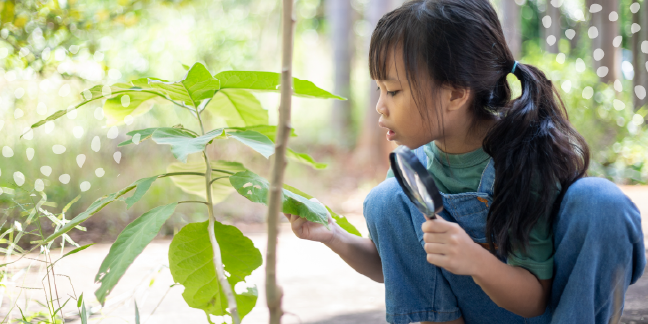Nature Was the First Classroom: The Deep Roots of Outdoor Learning
April 3rd, 2025 | 3 min. read
By Emily Garman

Outdoor education may seem like a modern innovation, but its origins stretch back centuries. Long before classrooms and textbooks, learning happened naturally—through hands-on experiences in the environment.
Indigenous communities around the world used nature as their primary classroom, fostering deep connections to the land and holistic learning experiences.
In this article, we’ll explore how outdoor education has evolved over time, uncover the science behind its benefits, and discuss why it’s more important than ever to bring these time-tested practices back into early childhood learning. Get ready to be inspired by the power of nature-based education!
The Deep Roots of Outdoor Learning
For generations, children learned through direct experiences with their environment. In Indigenous communities, education wasn’t confined to four walls—it was woven seamlessly into daily life. Young learners gained essential skills, cultural knowledge, and a deep respect for the land through storytelling, play, and hands-on discovery.
Indigenous scholar Kathy Absolon beautifully describes this balance of play and learning:
"Parents and elders allow play at the same time as teaching. A child’s own play and curiosity lend themselves well to teaching opportunities. Elders believe that is essential to learning."
This natural, immersive style of education nurtured a profound connection between children and their surroundings—an approach that modern educators are beginning to rediscover.
Bringing Back the Magic of Outdoor Learning
As industrialization and formal education systems expanded, the focus shifted from experiential, nature-based learning to structured indoor classrooms. While these changes brought new opportunities, they also distanced children from the hands-on, sensory-rich experiences that nature provides.
Dr. Rachel Larimore, author of Preschool Beyond Walls, offers this insight:
"In a true natural environment, there would be different things to explore and play with based on the seasons and time of year. This is not the same thing as having a play structure made from natural materials, like wood."
Place-based education extends beyond simply taking children outside—it involves bringing nature indoors and integrating local ecological elements into everyday learning spaces. Dr. Sandra Duncan and Christine Burkholder, experts in early childhood environments, define place-based education as intentionally designing spaces that connect young children to their surroundings, emphasizing nature, sensory experiences, and authentic interactions. (Check out their beautiful book on this topic, Inspired by Nature)
This approach can include incorporating natural materials like wood, stones, and plants into classrooms, designing indoor spaces to reflect local landscapes, and fostering connections to the community through field trips and local partnerships.
The Benefits of Outdoor Education
The research is clear—outdoor learning is a game-changer for young children. Some of the incredible benefits include:
- Enhanced Academic Performance: Engagement with nature has been linked to improved attention spans, problem-solving skills, and critical thinking abilities.
- Social and Emotional Development: Outdoor experiences promote resilience, teamwork, and self-confidence among children.
- Physical Health and Well-being: Regular interaction with natural environments encourages physical activity and has been associated with reduced stress levels.
- Environmental Stewardship: Early exposure to nature fosters a lifelong appreciation and sense of responsibility for environmental conservation.
Challenges in Contemporary Educational Settings
While traditional educational systems have long emphasized indoor, structured learning, there is a growing recognition of the benefits of outdoor, active experiences. However, recess and hands-on exploration opportunities are sometimes limited, despite research highlighting the positive impact of physical activity and nature exposure on academic success and overall well-being.
Nature-based preschools are gaining momentum, offering rich, immersive learning environments. As of 2022, approximately 800 nature preschools in the U.S. serve around 25,600 children. However, ensuring equitable access remains essential, as enrollment data indicates that some communities are underrepresented. Expanding these opportunities can help all children experience the many benefits of nature-based education.
As educators, we can work to make outdoor education inclusive for all children. This means:
- Integrate Curriculum with Nature: Design lesson plans that utilize local natural settings, aligning with educational standards while fostering environmental engagement.
- Collaborate with Indigenous Communities: Engage with local Indigenous groups to incorporate traditional ecological knowledge and practices into the learning experience.
- Advocate for Policy Changes: Work towards school policies prioritizing outdoor learning, ensuring adequate time and resources are allocated.
- Create Inclusive Outdoor Spaces: Develop natural play areas that reflect the cultural and ecological diversity of the community, so that students can embrace the richness of the natural world.
- Bring Nature Indoors: By weaving elements of the natural world into both indoor and outdoor learning, educators can create environments that nurture curiosity, deepen children's sense of place, and reinforce the intrinsic relationship between humans and nature.
Extending Outdoor Learning Beyond Early Childhood
Nature-based learning isn’t just for young children—it’s a powerful approach that benefits learners of all ages. Historically, children have engaged with the natural world as a key part of their education, and reintroducing outdoor experiences into curricula for older students can enhance cognitive, social, and physical development. By extending nature-based learning beyond early childhood, we can create enriching, hands-on opportunities that support growth at every stage.
Join the Movement!
By embracing outdoor education, we can reconnect children to the wonder of the natural world and set them up for success in all areas of development. Whether you’re designing a nature-based lesson, advocating for more outdoor playtime, or transforming your classroom environment, you are making a difference.
Whether you're looking for inspiration, guidance, ready-to-use ideas, practical strategies, research-driven insights, or creative activities that bring education beyond the classroom walls, Gryphon House is your go-to resource for integrating nature into everyday learning experiences.
Explore our collection of inspiring books that offer hands-on strategies, research-backed insights, and creative ideas to help you integrate outdoor education into your teaching.
Let’s create joyful, engaging, nature-filled learning experiences—together!
Emily Garman (she/they) works in the Gryphon House Books marketing department. She is passionate about environmental education and getting kids outside. When she's not writing or shooting video, you'll probably find her volunteering somewhere or singing in her community choir.